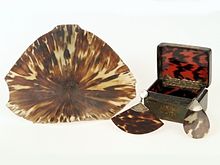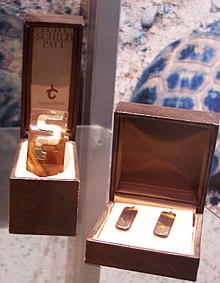Tortoiseshell
Tortoiseshell (also Bissa, Schildkrot from nordd. / Niederl. Schildpadde for turtle) is a biogenic material which consists of the flat horny scales (Scuta) of the back plate ( carapace ) of three types of sea turtles can be obtained.
origin
The pattern and thus the quality of the tortoise shell depend on the type of tortoise and the geographic origin of the animals. Light yellow tortoiseshell with brown to black markings, for example, comes mainly from East India. Light red-brown tortoiseshell with dark red-brown markings, on the other hand, comes from the Egyptian tortoise. American tortoiseshell is usually red-spotted. Single-colored light plates (blind tortoiseshell), on the other hand, are rare.
The carapace of the green turtle ( Chelonia mydas ), hunted for its meat, was only used for the manufacture of lanterns because of its small thickness. The loggerhead sea turtle ( Caretta caretta ) and the hawksbill sea turtle ( Eretmochelys imbricata ), on the other hand, have horn plates that are clear, translucent and brightly colored (yellow, red, brown, black), flamed or cloudy. Therefore, they were only caught for their tortoiseshell.
Tortoiseshell ( ba-sig 4 ) was already imported from the Persian Gulf under the kings of Larsa . The letter UET V 678 from Ur mentions 30 pieces ba-sig 4 . The ancient Egyptians also used tortoiseshell, objects made of tortoiseshell were also found in Nubian graves.
In the 18th and 19th centuries, tortoiseshell was mainly imported to Europe from the Bahamas , the Antilles , the Cape Verde Islands and from Guyana . The Dutch trading company imported tortoiseshell from the West Indies and the Moluccas and Spain mostly from the Malabar Islands. Further occurrences were found at the time in Madagascar , China , New Guinea and the Bismarck Archipelago .
The tortoiseshell was extracted in the regions of origin and shipped to Europe. Whole shiploads could be destroyed by worm infestation, as this was greatly favored by the long transport routes and the lack of air supply or circulation. In the European ports - such as B. Marseille , Amsterdam and Hamburg - the tortoiseshell was then sold to dealers and artisans by the pound.
In 1784 a pound of tortoiseshell cost 6 to 15 guilders in Amsterdam . In 1895, 9,305 kg of tortoiseshell worth 350,000 marks were sold in Hamburg .
Extraction
From the turtle shell, only the back shield was used, which consists of twelve panels arranged around a hexagonal center plate. In order to remove the coveted material from the turtle shells, heat is required. Writings from the 16th to 20th centuries indicate that living animals were placed in boiling water or held over a fire. The tortoise shell softened under this influence of heat and could thus be detached from armor with the help of a knife.
In the 18th century the meat of the turtles was not considered tasty. Since European hunters also believed that the tortoiseshell would regrow, if the animal survived the detachment process, it was released. In fact, it is found in Grzimek's animal life that the armor can almost be reproduced in quite young animals.
A usable tortoise shell yield of approx. 2.5 kg is obtained from a hawksbill turtle weighing approx. 75 kg.
Processing and use
The tortoiseshell is very similar to the horn and, like it, consists mainly of keratin .
The thermal properties of tortoiseshell make processing possible in the first place. If it is still hard and brittle when cold (the Mohs hardness is around 2.5), it becomes elastic and malleable when heated. However, if it is exposed to excessive heat, it may lose its transparency.
A typical processing operation initially involves leveling the shield panels. The plates are heated in boiling water until they are deformed by their own weight. After softening, the panels are pressed, but must not cool down too quickly. For this reason, bags of hot sand or preheated metal plates were used for the pressing process. The plates are then left to cool under pressure. The plates prepared in this way must then be leveled, i.e. H. brought to a uniform strength. In this way the transparency of the tortoiseshell can be worked out.
If larger pieces of tortoiseshell are required, individual plates can be welded together using a combination of heat and pressure.
With the help of heated metal molds, the previously heated tortoiseshell can be shaped into different shapes. After it has cooled down in the molds, it retains its new shape.
After the tortoise shell has been processed, the individual pieces are glued onto a wooden support. The transparency of the material is often used and the tortoiseshell is backed with colored paper. In addition to enhancing the color impression, this had the advantage that the grain of the wood does not show through and the pattern of the tortoise shell is easier to see.
Threats to sea turtles and conservation
The hunt for sea turtles because of their tortoise shells was largely responsible for the collapse of the populations of some tortoise species in addition to the drowning of many animals as bycatch in fishing nets and the destruction of the habitat by building up coastal areas. Through the Washington Convention on the Protection of Species of 1973 (ratified by the Federal Republic of 1976), the species concerned were therefore placed under strict protection and trade in tortoiseshell was prohibited. However, tortoiseshell items can still be found in some tourist regions as souvenirs. Importing into Germany is prohibited and subject to a penalty.
Another form of species protection is the use of substitutes. Imitations of tortoiseshell used to be made shortly after it became fashionable by staining to produce similar colors and drawings on white horn, bone glue and even ivory .
When celluloid was developed, it was used as a substitute for both ivory and tortoise shell. Celluloid was later replaced by the newer Galalith and finally by modern plastics such as Rodoit (cellulose acetate).
Web links
- Information page of the German customs on the subject of tortoiseshell and species protection
- Page no longer available , search in web archives: Information page of the Swiss Federal Food Safety and Veterinary Office (FSVO) on the subject of tortoiseshell and species protection
Remarks
- ↑ To make horn look like tortoiseshell, it is placed in a bath of 1 part nitric acid and 3 parts water at 30–38 ° C for a few hours, then covered in places with a paste made from 2 parts soda, 1 part quicklime and 1 Part of red lead, rinsed it off after 10-15 minutes, dries the horn by pressing on a cloth and puts it in a bath of 4 parts of redwood decoction at 10 ° B. and 1 part of caustic soda at 20 ° B., then rinses it off and dries and polishes it after 12-16 hours. (Compare Kühn: Handbook for comb makers, horn and footworkers. 2nd edition. Weimar 1864).
Individual evidence
- ↑ JG Krünitz: Economic-Technological Encyclopedia. P. 440
- ^ WF Leemans: Foreign trade in the Old Babylonian period as revealed by texts from southern Mesopotamia. In: Studia et documenta ad iura Orientis antiqui pertinentia. No. 6, Leiden 1960, p. 125.
- ^ Alfred Lucas: Ancient Egyptian materials and industries. London 1934, p. 50.
- ↑ a b J. G. Krünitz: Economic-Technological Encyclopedia. P. 444.
- ^ Fritz Spannagel: The turner's factory. P. 180.
- ↑ Lois Edgar Andres: Processing of horn, ivory, tortoiseshell, bones, mother-of-pearl. P. 134.
- ^ A b Ruth Remetter: Tortoiseshell, the material and possibilities of its processing. Munich 2002, pp. 9-10.
- ↑ Dr. Dr. HC Grzimek: Grzimek's animal life. Volume 6 Kriechtiere, pp. 110–111.
- ↑ Katharina Walch: Boulle marquetry in southern German monastery furnishings of the 18th century. In: Research and reports for the year 1988, Munich 1993, p. 110.
- ↑ JG Krünitz: Economic-Technological Encyclopedia. P. 450ff.
- ↑ Ruth Remetter: Tortoiseshell, the material and possibilities of its processing. Munich 2002, p. 12.

